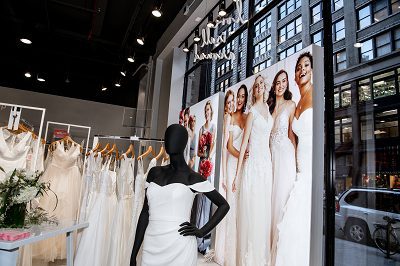 It’s been just a few months since James Marcum took the CEO job at David’s Bridal, and to hear him share the retailer’s story, the honeymoon is still on. Prior to Marcum’s arrival, the 330-store retailer came through a bankruptcy reorganization in less than two months, shedding approximately $450 million in debt without having to close any store locations. Unlike many retailers that have experienced financial troubles, Marcum sees the David’s Bridal national store footprint as one of its major assets, along with:
It’s been just a few months since James Marcum took the CEO job at David’s Bridal, and to hear him share the retailer’s story, the honeymoon is still on. Prior to Marcum’s arrival, the 330-store retailer came through a bankruptcy reorganization in less than two months, shedding approximately $450 million in debt without having to close any store locations. Unlike many retailers that have experienced financial troubles, Marcum sees the David’s Bridal national store footprint as one of its major assets, along with:
- The breadth of its assortment, sizing and services, including alterations, customization and accessories;
- Improved alignment between its in-store and online customer experiences, designing them to meet the changing requirements of today’s wedding consumer; and
- The retailer’s vertical supply chain, which should help the company navigate the current trade wars.
Retail TouchPoints (RTP): It’s a pretty rare feat for a retailer to come through a bankruptcy without closing any of its stores. How was David’s Bridal able to accomplish this?
James Marcum: With the speed of this bankruptcy, the retail footprint was an asset. Typically the major factor in [deciding about store closures] is, are you a destination location, or are you relying on the traffic generated by others to do business? It’s complicated when a retailer is sitting in a mall, because it becomes a question of, Who is your customer in relation to the other tenants? But with David’s Bridal, the stores are primarily located in strip mall locations and they are a destination for the bride, and the entire event.
Brides may get their inspiration online, but the majority of them want to see, touch and feel the dress itself, and to try it on. The purchase is experiential and very emotional, so a brick-and-mortar store is needed for this very high-touch purchase.
That’s a key reason that the company saw the need to retain stores in their markets, as a way to satisfy customers on a national scale. David’s Bridal still has a 25% share of the wedding dress market, and that national scale means we are more likely to help de-stress a situation by getting bridesmaids their dresses wherever they are throughout the U.S.
RTP: What were the key factors that led to the company’s financial problems?
Marcum: In short, the customer changed, and we didn’t keep pace with her. In the early days of David’s Bridal, prior to the digital environment of today, brides would get inspiration from a bridal magazine. They would tear out a few pages, run into a boutique or their local David’s Bridal store, and the inspiration would turn on availability and the selection there. Today’s consumer gets her inspiration digitally, from Pinterest, Facebook, YouTube and Instagram. That’s the new front end of the funnel, and there have been a lot of competitors there who got an equal shot at the customer, in part because it’s very easy to advertise in that world.
Another big issue was that when David’s Bridal did develop its e-Commerce strategy, several of our internal initiatives were misaligned. The company hired digitally savvy people who were focused on doing more unit volume, but that translated into different pricing, promotional strategies and customer policies between the web and the store. For instance, with an e-Commerce purchase you would get immediate delivery, while a store purchase would take four weeks. Online purchases could be returned, while in-store purchases were final. Our incentive programs were misaligned in terms of rewarding people for what was sold in the stores.
All those issues are fixable, and we have spent a significant amount of time and money on all our customer touch points, particularly our digital strategies. We’re promoting via organic search and paid social to tell our story to our brides, about what our value-add is, what we deliver and how we deliver it. We’ve been asking ourselves — how do we improve our ability to play in the whole digital world so that we’re part of the inspiration and sharing?
RTP: How do you see the bridal sector being affected by larger trends going forward, such as the trade war?
Marcum: One of our other strengths is that we own our supply chain, so we are vertical in most of our categories. The majority of dresses we sell come out of our own factories, which are located throughout Asia. We manufacture in China but also in other countries, and the majority of our product is proprietary. That’s important, and it’s also kind of amazing when you think about bridesmaid dresses, because one out of five of them aren’t cut until the order is made. You might see a dress on a mannequin that takes 54 hours of work to create, with a lot of handmade features, and it’s retailing in our stores for under $1,300. I don’t know many retailers that can bring that level of value.
We’ve done a lot of work around tariffs, to figure out what is sourced out of China and how. We’re working with our partners out of our design center in Shenzhen, and I would say we’ve been very successful in nominalizing the cost impact. Over time, as this trade war goes on, we will continue monitoring and being fluid so we can continue to respond to it.
RTP: You brought a combination of retail and financial/consulting experience to this job. How has that helped you in this role?
Marcum: I’m a retail operator at heart, but getting a perspective from the ‘other side of the table’ is invaluable. It helps you predict, anticipate, forecast and understand issues such as liquidity, and it’s helped round me as a leader. It gives you a different perspective when you’re coming into a company, especially one that has come through stress. Work on the private equity and advisory sides also gives me perspective about what’s changing in retail — consumers’ migration to online, Millennials passing the torch to Gen Z, direct-to-consumer (DTC) strategies. I also have a great respect for how private equity looks at and values a business — the need for speed, for execution and a sense of urgency. All of those are critical to any business.
RTP: What is the part of your job that you personally enjoy the most?
Marcum: I enjoy engaging cross-functionally with our leadership teams to work on how our business impacts the customer. We are working very quickly with very large initiatives across the company, and it’s truly engaging when you see the culture of the company standing up to accomplish this.
I also enjoy interacting with the customer herself. We’ve brought on board a new Chief Store Experience Officer to work on how we engage the customer and create a great culture. I also enjoy scraping through the negative comments we receive. I’ll often engage directly with these people. Many times and a lot of nights, I’ll reach out to these customers myself. I enjoy it.













